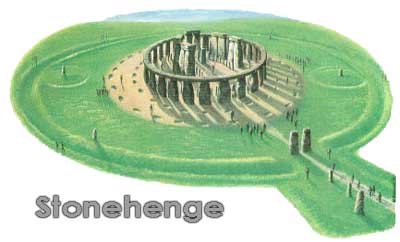BAMBU-18
Brit-Am Megalithic Bulletin Update
SCROLL DOWN \
Tracing The Israelite Paths of Migration
according to the Directions of the Prophet Jeremiah 31:21

BAMBU-18
Brit-Am Megalithic Bulletin Update
22 Tammuz 5770 4 July 2010
Contents:
1. Dolmens in India and France-connection?
DOLMENS IN JAPAN.
2. Dolmens of North Caucasus.
3. Megaliths in Urals Show Link to the Middle East
Isle of Vera - Standing Stones in Russia
4. The Megalithic Structures of Vera Island in Turgoyak Lake, Southern Urals
5. Perhaps the Stone Age in Scandinavia Did Not exist?
Thunderstone Mystery: What's a Stone Age Axe Doing in an Iron Age Tomb?
| Site Contents by Subject |
Home Research Revelation Reconciliation |
Publications |
Site Map Contents in Alphabetical Order |
This Site |
1. Dolmens in India and France-connection'
DOLMENS IN JAPAN.
http://en.wikisource.org/wiki/Popular_Science_
Monthly/Volume_16/March_1880/Dolmens_in_Japan
By EDWARD S. MORSE.
Extracts:
A dolmen, generally speaking, consists of an axTangement of stones, few or many in number, supporting one or more stones in such a way as to inclose a cavity beneath. These supporting stones may form the four walls of a chamber, which may or may not be covered by a mound of earth. This chamber may or may not communicate outwardly by a long, narrow gallery {allee couverte). The mound may or may not have one or more rows of stones encircling it. And, finally, the stone structure may be on top of a mound of earth, instead of beneath it !
The simplest form of dolmen, if indeed it can be compared to the more elaborate structures bearing the same name, consists of several standing stones supporting one or more stones which rest upon them horizontally. If the roofing-stones rest with one end upon the ground, then it is called a demi-dolmen. A holed dolmen has one of the sup- porting stones (which generally forms one side of a square chamber) perforated. The demi-dolmens are not sufficiently specialized to establish any line of distribution. The holed dolmens are found in France and in India, and their curious resemblance has led many to believe in their common origin.
In the mound-covered dolmens a relationship is also seen between those of Brittany and Scandinavia, in the passageway generally opening toward the south or east and never to the north.*
From the mass of observations brought together regarding the dolmens, Mr. Fergusson f has prepared a map showing their distribution in the Old World. From this map, dolmens are found to occur in the greatest number in France. They are also found in various parts of Great Britain, more abundantly on the eastern coast of Ireland, western coast of Wales, eastern coast of Scotland, southern portion of Sweden, and in Denmark and Northern Germany ; also on the coast of Spain, Portugal, Northern Africa and the western portion of India, Mr. Fergusson, at the date of the publication of his book, asserts that the typical dolmen had not yet been found in America.
The occurrence in different parts of the world of a mound of earth containing a stone vault or chamber can not be looked upon as evidence of a community of origin, because such a structure seems to be a most natural form for the purposes of burial. The same structures are built to-day in many countries. It is only when it possesses some peculiar feature, like a perforation in one of its wall-stones, or a certain direction in which the passageway opens, that it suggests the idea that a common origin may be ascribed to those possessing these peculiarities.
The dolmens are found in the villages Hattori Gawa and Kori Gawa, which lie at the base of a low chain of mountains. Having reached Hattori Gawa, we left ovoc jinrilcishas, and hunted up the head- man of the village who was to accompany us to the dolmens.
In Fergusson's work, already alluded to, there is figured a dolmen of Uby, Scandinavia, page 311, and Antiquera, Spain, page 383, which resemble in many features the dolmens near Osaka [Japan]. Jewitt also, in his work entitled " Grave-Mounds and their Contents," figures the dolmen of New Grange, Meath, Ireland, page 57, and the cairn of Howth, Ireland, page 58, which again recall similar features to those of the dolmens described in this article. In the cairn of Howth the passageway is twenty-seven feet long.
2. Dolmens of North Caucasus
http://en.wikipedia.org/wiki/Dolmens_of_North_Caucasus
Extracts:
The Caucasian dolmens represent a unique type of prehistoric architecture, built with precisely dressed large stone blocks. The stones were, for example, shaped into 90-degree angles, to be used as corners or were curved to make a circle. The monuments date between the end of the 4th millennium and the beginning of the 2nd millennium B.C.
While generally unknown in the rest of Europe, these Russian megaliths are equal to the great megaliths of Europe in terms of age and quality of architecture, but are still of an unknown origin. In spite of the variety of Caucasian monuments, they show strong similarities with megaliths from different parts of Europe and Asia, like the Iberian Peninsula, France, Great Britain, Ireland, Netherlands, Germany, Denmark, Sweden, Israel and India. A range of hypotheses has been put forward to explain these similarities and the building of megaliths on the whole, but still it remains unclear.
Approximately 3,000 of these megalithic monuments are known in the Western Caucasus, but more are constantly being found, while more and more are also being destroyed.
The repertoire of decoration for these tombs is not great. Vertical and horizontal zigzags, hanging triangles and concentric circles are the most common motifs. One decorative motif that is quite common is found across the top of the porthole slab. It can best be described as a lintel held up by two columns. Pairs of breasts, done in relief, have also been found on a few tombs. These breasts usually appear above the two columns of the porthole decoration. Perhaps related to these are the stone plugs, which were used to block the porthole, and are found with almost every tomb. They are sometimes phallic-shaped.
Some unusual items associated with dolmens are big round stone balls, double balls and animal sculptures.
Other important megalithic sites of Russia have been found along Russia's northern shores with the White Sea [east of Finland] and the Barents Sea [north of Finland] as well as at Vera Island [Lake Turgoyak of the Chelyabinsk region in the Ural Mountains].
3. Megaliths in Urals Show Link to the Middle East
Isle of Vera - Standing Stones in Russia
http://www.megalithic.co.uk/article.php'sid=19208
Extracts:
'Among the most interesting monuments of the isle are its megaliths, similar to the famous megaliths of the Western Europe and Middle East. The largest of them is about 18 meters long, and weighs about 17 tons. Most likely, it is a temple complex related to the sun calendar cult,' added Grigoryev.
'These megaliths are at average six thousand years old. Their further study may possibly change the history of the mountain forest zone of the Urals in the end of the Stone Age. Megaliths will help us follow connections between the Urals and the Middle East,' said Grigoryev.
4. The Megalithic Structures of Vera Island in Turgoyak Lake, Southern Urals
By S. A. Grigoriev (stgrig@mail.ru)[1] and Y. V. Vasina (semantik@mail.ru)[2]
http://www.comp-archaeology.org/GrigMegtUrals.htm
Extracts:
Megalithic structures are probably the most impressive prehistoric sites. Different types of megalithic structures are known from the Mediterranean, Northern and Atlantic Europe (Map of Europe). They include individual menhirs (standing-stones), alleys of menhirs (menhir alignments), dolmens, gallery graves, rock-cut tombs, etc. Until recently, only the dolmens of the Western Caucasus represented these types of sites in Eastern Europe. During the last years, relatively small alleys of menhirs are also found in the Urals, but the size of these sites and the labor inputs for their construction are not striking. Therefore, their designation as megalithic structures must be viewed with some reservation. However, field studies conducted during the last three years resulted in the discovery of a new type of archaeological site in the Urals, which may be considered true megalithic structures.
Vera Island is situated in Turgoyak Lake to the north of the City Miass in the Chelyabinsk area . This area of the Southern Transurals is probably the most beautiful in the Urals. It consists of a forest landscape with small mountains and hundreds lakes. Turgoyak Lake is one of the largest of these lakes. Vera Island was formerly a peninsula, but it is now detached from the shore by a narrow channel.
The derivation of the name Vera Island is significant. Usually 'Vera' is a female name, but in Russian it also means 'the faith' and 'the belief'. In the 19th century AD, a small community of Old Believers lived on the island. Their believes resulted in a kind of schism in the Russian Church between AD 17th to the 20th century. There is a legend that the settlement of the Old Believers was established by the nun Vera, who with the help of a local fisherman built the megalithic structures, which forms the subject of this report. However, in reality the settlement of the Old Believers was bigger and consisted of several pit-dwellings, suggesting a relatively large community.
In 2001, V. L. Korolyov, a connoisseur of the Ural history and the manager of cultural heritage, visited the island, inspected the 'caves' and concluded that they could not be constructed by the Old Believers. In 2002 he invited the archaeologist Dr. S. A. Grigoriev to inspect these structures. The archaeologist confirmed this conclusion.
Megalithic Structure 1
Structure 1 is a rather complex megalithic construction (Fig. 5, 6). It is erected along the ridge of a hill, where it is cut into the bedrock. A turf layer covers the capstones. The stones, visible on the surface, look like natural rock outcrops (Fig. 6). If the structure had not been reused by the Old Believers, it would have been extremely difficult to identify it.
In the south side of the construction, small openings are visible. In front of them there are depressions on the modern surface. These are the remains of two chambers destroyed in antiquity (Fig. 7, 8).
The construction is covered by massive stone slabs (capstones). The covering of the megalith is a complicated multi-layer construction, which creates a dynamic balance of slabs. The capstone length varies between 1.5 and 3.5 m, depending upon the width of the covered area. The width of the slabs is 0.75-1.3 m. The central chamber exhibits the largest capstone, reaching 2 m in length. We estimate the weight of this slab as 15-17 tons (Fig. 14). The slabs are covered by the mound made of sand.
The thickness of the walls is 0.75 m, reaching 1.2 m in the upper part. Their height is 0.5 m in the corridor and more than 2 m in the central chamber.
The excavation of the mound has been conducted on the southern slope (Fig. 24). The thickness of the mound under the capstones is 20 cm (Fig. 25). The capstones rest on the sidewalls. The stones of the walls and stones of the mound were covered with the sandy mound fill. On the surface of the sand under the slabs a sherd of the Lipchinka culture of the Copper Age (Eneolithic) and a flint arrowhead was found there (Fig. 26.2-9). In addition, flakes, blades and one core were found among the stones of the mound. The lithics were made of flint and jasper. Three sherds, similar to those of the Gamayun culture of the Late Bronze Age and Early Iron Age, have also been found in the lower part of the mound (Fig. 26.1).
This demonstrates that the construction had been erected in the Copper Age, and reused in the Early Iron Age as well as the 19th century AD.
The traditional notion that the megalithic structures were built by the Old Believers in the 19th century AD is questionable. The reuse of the megalithic structure with clear traces of rebuilding for the purpose of adapting it for the needs the Old Believers argues against the traditional explanation. It is, perhaps, even more important that the Old Believers and the Russian people as a whole do not have a tradition of megalithic architecture.
In historic times, timber structures are the usual architecture in the area and plenty of timber is available on the island. Furthermore, the effort required to transport the stone slab capstones weighing 5-17 tons seems to negate the notion, since timbers are the more convenient material for roof construction.
As a rule, the historical pit-dwellings are situated in natural depressions. This saves labor by reducing the volume of soil that has to be extracted. This contrasts with the megalithic structures, which are situated on the ridge of the hill and are completely built of stone. The megalithic architecture , especially for the building of Structure 1, requires far greater expenditure of labor.
In the Urals, where the winter temperatures reach -40'C and more, megalithic architecture cannot be used as dwellings, because of their poor heat-insulating quality. They could only be used in the warm seasons. This is why N. Filyanskii supposed that Structure 1 was used as a refectory.
For these reasons, the megalithic structures are undoubtedly more ancient. This is confirmed by ancient artifacts from stratigraphically regular levels. These include artifacts from the Lipchinka culture of the Copper age and earlier ones from the Neolithic. The Lipchinka culture belongs to the earliest part of the Copper Age (i.e. the Early Eneolithic). According to the traditional system of the Ural chronology, this period is dated to the first half of the third millennium bc (cal. fourth millennium BC).
Neolithic artifacts may imply an even earlier building period for the megalithic structures. Of course, it is possible that the materials of the Neolithic were contained in the sand accidentally taken from a Neolithic site used for quarrying mound fill that covers the megalithic structure. The sand and artifacts could eventually have fallen into the chambers. However, this idea has been examined during our excavations and can be discarded, because the corridor into the northern chamber is covered quite well, thus excluding this possibility there. In addition, geologist Nikolsky compared sand from different places on the island. All Neolithic sites are situated below the elevation of the megalithic structures, on the bank of the lake. The sand there has other granulometric characteristics. The sand from the megalithic structures comes from the immediate surroundings of the site and from the same elevation (8-10 m above the water) of the island. This makes evidence would suggest a construction period prior to the cal. fourth millennium BC. However, there is no known megalithic architecture within reasonable proximity of the Urals during this time, to justify such an early date.
The closest analogy to the megalithic structures of Vera Island is with the megalithic tombs of Western Europe (M'ler-Karpe 1974, Baldia, 2004). In addition to general similarities, such as the use of stone blocks for walls and the use of stone slabs as capstones, the adduced existence of a mound over the megalithic structure allow a comparison with gallery-graves from that region.[3] The comparison with the megalithic tombs of Europe (based on Baldia, 2004) allows the tentative conclusion that the megalithic structures on Vera Island date to around 2700-2500 bc (or cal. 3400-3200 BC). This is supported by the presence of the Copper Age artifacts, dated to the third millennium bc (cal. fourth millennium BC). However, the nature and reason of the appearance of megalithic structures on Vera Island remain unclear.
5. Perhaps the Stone Age in Scandinavia Did Not exist?
Thunderstone Mystery: What's a Stone Age Axe Doing in an Iron Age Tomb?
http://www.sciencedaily.com/releases/2010/06/100614101724.htm
ScienceDaily (June 16, 2010) ' "If one finds something once, it's accidental. If it is found twice, it's puzzling. If found thrice, there is a pattern," the archaeologists Olle Hemdorff and Eva Thatesay.
In 2005 the archaeologists investigated a grave at Avaldsnes in Karm' in southwestern Norway, supposed to be from the late Iron Age, i.e. from 600 to 1000 AD. Avaldsnes is rich in archeological finds. They dot an area that has been a seat of power all the way back to around 300. Archaeologist Olle Hemdorff at the University of Stavanger's Museum of Archaeology was responsible for a series of excavations at Avaldsnes in 1993-94 and 2005-06.
"It became clear to us quite early that the grave had been plundered. The material in the grave had been messed up and now contained brick and porcelain fragments from younger layers of soil," Hemdorff says.
Plundering of graves was very common in the 19th century and actually legal. It was not until the Cultural Heritage Act in 1905 made it a criminal offence for lay persons to excavate cultural monuments.
Axes and pearls
The German archaeologist Eva Thateis in the spring of 2010 visiting researcher at the Museum of Archaeology. She is also a guest researcher at the University of Chester in England. The cooperation with Hemdorff started in 2003 when Thatecame to Stavanger in connection with a doctoral work on the recycling of ancient tombs. The latest research project carried out by the two archaeologists is on finds of older artifacts in younger graves. In the grave at Avaldsnes the researchers found seven handsome glass pearls in the dirt.
"In the late Iron Age glass was the most common material for making pearls, and therefore glass pearls are often found in men's and women's graves from this period. The women wore the pearls in a cord around the neck and brought more pearls with them into the grave than men did. The discovery of the seven pearls made us assume that it was a woman's grave we investigated," Hemdorff says.
"But then we suddenly found a stone axe. It was in the same layer of soil as some of the pearls. The axe is from the Stone Age and more than a thousand years older than the pearls! It is a so-called greenstone axe. All the other indicators suggested that the cairn was from the Iron Age and belonged to a buried woman. So why was there an old axe from the Stone Age in the grave'," the archaeologist asks.
Not accidental
During the last three years documented discoveries of artifacts have been made that are typical for the Stone Age -- marks from flint, flint fragments, quartz, axes, etc. in younger burial mounds.
"Unfortunately this documentation did not begin until the 1970s. Up to that date neither archeologists nor grave robbers were aware of these objects. They were just seen as unimportant and without archeological value. It is only now that we are beginning to have enough data for analysis, and we have made many enough discoveries of Stone Age artifacts in younger graves to say that they make a clear pattern," Thatesays.
She points to a good example from Sogndal in Sogn og Fjordane where a stone axe was found in an untouched stone coffin from the 5th century.
"The axe must have been placed there intentionally. Other finds in Scandinavia make this pattern even clearer. In Halland in Sweden they have found a burial site consisting of almost one hundred graves from the late Iron Age where one has registered processed flint objects in nearly every grave," Hemdorff says.
Starting with the finds around the grave at Avaldsnes and taking the other finds into account, it is not likely that the axe ended up in the grave by accident. Why was it deposited there?
Thunderstones from the sky
The researchers say that people back in the Iron Age had a conscious relationship to objects from earlier times that connected them to their past.
"People probably considered old objects as a heritage from their ancestors. Recycling of old burial mounds for new graves is an indication of this relationship. The idea was that the mounds were memories from a distant past, and written sources indicate that recycling of mounds had a double function. Apart from providing a grave for the dead they also legitimized property and rights. People asserted their control over an area by burying their family in a gravesite belonging to their ancestors," Thateexplains.
The archeologists think that people in pre-history were superstitious and that the axe was deposited in the grave as a part of the burial ritual.
"People believed that the lightning created thunderstones and that individuals who owned such stones would not be hit by the lightning," Hemdorff says.
The idea of a rock falling from the sky caused by lightning is known all over the world. It is certainly found in Roman times and it is connected to objects like meteors, flint stone axes and petrified sea urchins.
"According to folklore a flint axe might protect against lightning and function as a kind of charm," Thatesays.
In Northern Europe the old idea of the thunder god Thor, who throws his hammer when lightning strikes, is common property. It was alive all the way up to the 19th century.
"Thor's mission was to protect gods and people against evil and chaos and it was therefore believed that Thor's rocks protected houses and people. Two things seem to be important when choosing thunderstones: The form had to be similar to an axe or a hammer, that is a ground stone or flint, or the stone had to have "flaming" properties, which flint and quartz have," Hendorff says.
Phallus and fertility
"Both the form of the axe and the flint stones to make fire may be associated with fertility. Thor's hammer is clearly linked to fertility and prosperity. The hammer is a phallus fertilizing the soil, which gives it apotropaic quality, i.e. it has the ability to protect against evil and accidents," Thate explains.
Since people imagined that thunderstones fell to the ground in connection with lightning, it is possible that the rocks incorporated some of the qualities of lightning or had the power to create a bright light.
"Here is a clear pattern once more. We find old artifacts made of flint in the younger burial mounds. Flint had a strong symbolic power. The stones created fire and were seen as important objects. They can also symbolize the power of lightning," Hemdorff says.
The Avaldsnes axe
But now back to the axe at Avaldsnes and the question why it was in the plundered grave.
"If you consider how widespread the idea of thunderstones was all the way up to the 19th century, and how common superstition was, it is not unlikely that the grave robbers left a protective amulet to make up for their misdeed. After all they opened a grave and committed sacrilege. Maybe they hoped that the axe provided protection against the spirit of the dead and their ghosts," Hemdorff says.
More excavations of graves and houses with unusual artifacts and comparing them to data from different places will probably yield an even clearer pattern.
Thunderstones are definitely of great archaeological value.
See also:
BAMBU Archives: Contents
For a Map and List of Israelite Migratory Routes see:
http://www.britam.org/Questions/QuesHistory.html#Migratory
For more maps of the Megalithic Trail of Migration see:
http://www.britam.org/Proof/Attributes/roleDolmen.html
There is much archaeological evidence some of which we have quoted in the past.
http://www.britam.org/Questions/QuesArchaeology.html#Stonehenge
Dolmens and the Bible
http://www.britam.org/Proof/Attributes/roleDolmen.html
Answer to Queries on Archaeology Question no.3:
"What do Dolmens and other megalithic monuments such as Stonehenge tell us?
http://www.britam.org/Questions/QuesArchaeology.html#Israel
 |
Skewes Jewelry 
|
 |
 |
